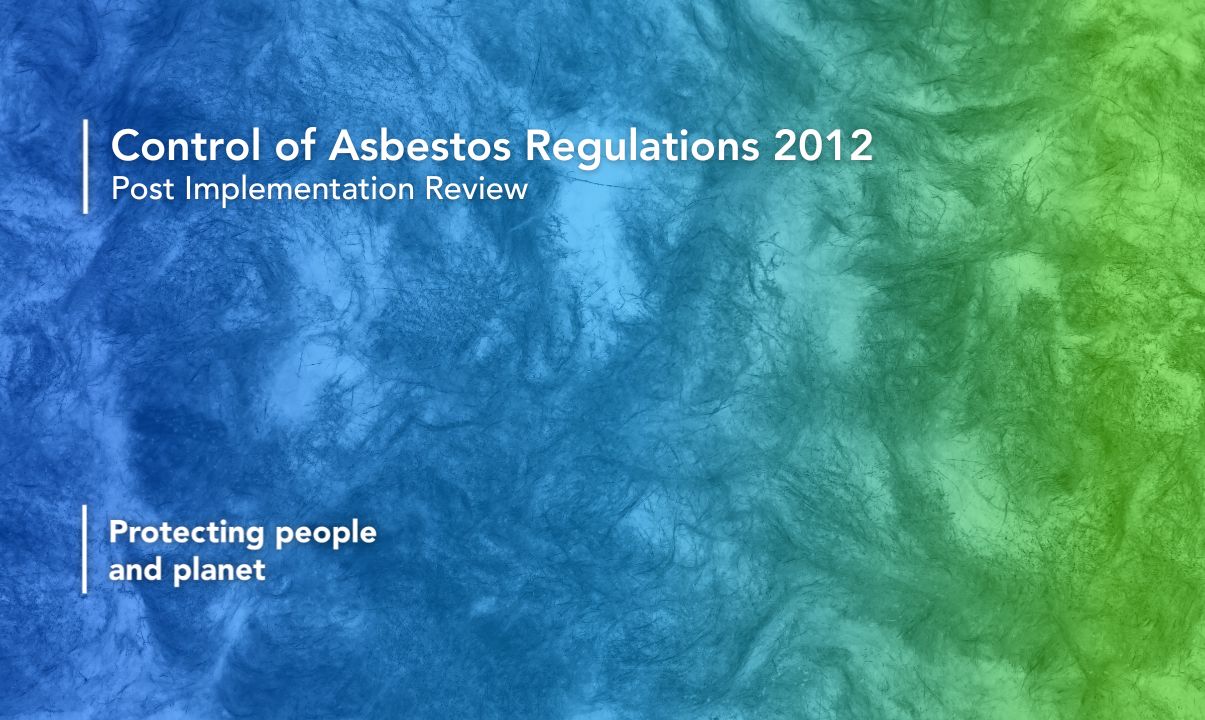Asbestos Management: Taking a Proactive Stance Against Complacency
22 September 2023
While considerable headway has been achieved, a worrisome sense of contentment has taken hold when it comes to managing asbestos, giving rise to concerns over diminishing compliance standards and service excellence.
In September Group QHSE Director Chris Parr presented at the IOSH Tyne and Wear Branch in-person event ‘Current Trends in Asbestos and Legionella Management’. Following Chris’ presentation, in our latest insight, Chris explores the intersection of fiscal austerity and diminishing industry quality and unveils potential connections between financial constraints and the erosion of industry standards. Challenging the prevailing "status quo" mindset, Chris urges a re-evaluation of entrenched practices in light of emerging net zero requirements and innovative technology.
Stressing the imperative of persistent growth and renewal in asbestos management techniques, Chris underscores the significance of quality service delivery, education, and knowledge enrichment.
During the periods of 1920 – 1970 and 1971-2000, Europe used 48% and 58% of the entire world’s trade of asbestos, arguably making Europe the historical global centre of asbestos use; the UK, Germany and France being the highest importers.
In the UK during the 1950s, 60s and 70s there was a ‘building boom’, in which amosite asbestos was used inside buildings as insulation/insulative products and chrysotile asbestos was used primarily in cement and external cladding.
Since the ban of asbestos in the UK in 1999 and extensive research conducted into the harmful effects of asbestos, it has long been recognised that the disturbance of Asbestos Containing Materials (ACMs) in older buildings can lead to harmful fibres being released, with dangerous health risks to individuals.
After many years of inaction and a disjointed approach to asbestos management between the Health and Safety Executive (HSE), the asbestos industry and professional bodies, the past 18 months have seen a marked change in collaboration to protect people and the environment.
A Historical Timeline Of Asbestos In The UK
Below is a historical overview of asbestos in the UK, including the progress we have seen since the introduction of the Control of Asbestos Regulations in 2012.
Click to expand the image below to full page for an interactive experience detailing each historical point.
The Asbestos Regulations
In 2011, the European Commission determined that British regulations didn’t fully implement its directive to limit asbestos exposure (Infringement number 2006/50422).
As such, new legislation was drafted and the Control of Asbestos Regulations 2012 (CAR 2012) came into force on 6th April that year, aimed at providing a more efficient system of control.
There are strict HSE and legal duties placed on people in charge of public buildings (‘Duty Holders’) aimed at reducing the risks to health that ACMs pose, and as such there should no longer be any excuse for anyone being exposed to potentially dangerous levels of airborne asbestos fibres in any building.
Current UK policy considers that asbestos which remains in good condition and is unlikely to be damaged or disturbed is not a significant risk to health as long as it is properly managed. Only when ACMs are disturbed or damaged is the risk of exposure increased by releasing airborne fibres. As materials in these buildings inevitably deteriorate over time, many campaign groups and industry professionals argue that a policy of waiting for materials containing asbestos to deteriorate before removing them is not proactive, allowing unnecessary risk to remain in place.
Many organisations call for the complete removal of asbestos from all buildings nationwide. However, to action, this would incur a great cost. According to Think Tank ResPublica, an estimated six million tonnes of asbestos remain inside 1.5 million buildings in the U.K. Removing these potentially lethal materials completely could result in many schools, hospitals, and other public buildings being shut down due to the soaring associated costs with the complete removal. The cost to councils and the taxpayer arguably would be crippling and unmanageable.
Significantly, the Work and Pensions Committee recommendations, which the government stated in August 2022 that they will not be accepting in full, supported the move, recommending that the HSE, should produce a robust, system-wide strategy to remove all asbestos-containing materials from non-domestic buildings within the next 40 years (2062).
During the past few years, especially during the COVID-19 pandemic where buildings have not been occupied, enforcement of the regulations and re-inspections have slipped. In recent times many companies have faced challenges posed by fiscal austerity. In the face of the economic downturn, some companies have divested from their risk management activities, leaving room for exposure to people and the environment.
It’s important to remind ourselves of the Duty Holder's role, knowing who they are and what they're responsible for.
Duty Holder Requirements
The Duty Holder is the owner of the non-domestic premises or the person or organisation that has clear responsibility for the maintenance or repair of non-domestic properties for example through an explicit agreement such as a tenancy agreement or contract.
The duty holder must comply with the Control of Asbestos Regulations 2012 and reduce the risks of exposure to asbestos as far as reasonably practicable.
The UK's current policy suggests that well-maintained and undisturbed asbestos is generally not a significant health hazard as long as it's properly managed. However, the danger arises when ACMs are damaged or disturbed, releasing airborne fibres.
The role of the Duty Holder is to minimise health risks associated with ACMs. Engaging with asbestos consultants with specialised building knowledge to assess individual premises based on factors like age and construction type is essential. It is also essential for Duty Holders to have up-to-date knowledge about asbestos risk and the current status of their buildings to be able to effectively manage their suppliers.
To properly address asbestos-related risks, it is crucial to follow a structured approach consisting of three key initial steps:
- Evaluation: Begin by engaging a trusted asbestos service provider to conduct a thorough asbestos survey of the premises. This survey will determine the presence of asbestos, assess its condition, pinpoint its location, and gauge the associated risks.
- Risk Assessment: Assess the potential dangers posed by asbestos within the premises based on the survey findings.
- Occupancy Consideration: Depending on the determined risk level, it may be necessary to limit access to the building until asbestos removal or safe management measures are completed, and a reoccupation certificate is obtained.
Following these initial steps, the subsequent actions are crucial to effectively manage asbestos risks:
- Establish and put into action a comprehensive management plan.
- Periodically review risk levels and document your observations.
- Evaluate any tasks that may expose employees to asbestos.
- Share pertinent information with relevant parties, such as other employers (e.g., construction contractors), who might encounter asbestos during their work. Ensure they implement appropriate safety measures when dealing with asbestos-containing materials.
- Implement measures to minimise exposure to the lowest achievable level.
Neglecting proper asbestos risk management can lead to significant repercussions, including:
- In lower courts: Facing the possibility of unlimited fines and up to 6 months of imprisonment
- In higher courts: Incurring potential unlimited fines and up to 2 years of imprisonment
Ultimately, mishandling asbestos management not only endangers human lives but also poses a significant threat to the environment.
As discussed, the parameters for managing asbestos are wide with little enforcement. Duty holders can easily get lost in the variety of supplier report types and inconsistencies in descriptions and documentation. To negate this, multiple industry bodies are pushing for the removal of asbestos from all buildings within 40 years. Whilst this isn’t financially practical and would be particularly damaging for the public sector, with the UK Government's commitments to a greener future, retrofitting could force the issue.
UK's Path to Net Zero: Balancing Progress and Asbestos Risks
The UK Government is committed to reaching Net Zero greenhouse gas emissions by the year 2050, a goal established in 2019 to combat the pressing issue of climate change.
Substantial strides have already been made, resulting in a nearly 50% reduction in emissions. Nevertheless, achieving Net Zero demands an even more ambitious target – a 78% reduction in emissions by 2035. This transition transcends the realm of energy production, necessitating a profound reconfiguration of transportation systems, residential structures, commercial enterprises, and land usage. It entails transforming the way people and goods are transported, how buildings are heated, and how consumption and production patterns are managed.
The pursuit of Net Zero presents lucrative commercial and economic opportunities for the United Kingdom. Taking decisive measures to attain this goal is not only environmentally imperative but also vital for maintaining the country's competitive edge in the global business landscape. Nevertheless, several significant challenges obstruct the active participation of business owners. These challenges include the concealed expenses linked to retrofitting in the built environment, such as the management of hazardous materials, including asbestos.
Asbestos and ESG
The UK's green finance markets are increasingly demanding more comprehensive evidence related to Environmental, Social, and Governance (ESG) and the UN’s Sustainable Development Goals (SDG) as a crucial part of their due diligence process. The effective management of hazards within buildings is directly tied to the increase in asset value.
ESG considerations are now wielding significant influence in decisions pertaining to mergers, acquisitions, and business development. Companies are under increasing pressure to disclose their ESG risks and opportunities, their strategies for mitigating these risks, and the financial implications of these efforts. This disclosure is vital to appease various stakeholders, including investors, customers, employees, and government entities. ESG encompasses three critical dimensions: Environment, Social, and Governance, each of which pertains to a company's impact on the physical environment, its interactions with people, and its framework for decision-making.
As previously discussed, asbestos poses a significant health hazard at various stages of an asset's lifecycle across all sectors. The release of asbestos into the environment during activities such as construction, demolition, mining, and manufacturing can result in contamination of the air, water, and soil. This contamination can lead to asbestos inhalation from the air, ingestion through water, and its re-release into the air due to soil disturbances.
The effective control and management of asbestos and the prevention of associated harm arguably fall within all three dimensions of ESG:
Environmental (E)
- Asbestos is a naturally occurring mineral that was widely used in construction and other industries for its fire-resistant and insulating properties. However, it is also a known carcinogen and poses significant environmental risks.
- From an ESG perspective, asbestos is a concern because its extraction and use can result in environmental harm. Mining and processing asbestos can lead to soil and water contamination, affecting ecosystems and potentially causing health problems for nearby communities.
Social (S)
- The social aspect of ESG includes factors related to how a company or industry affects people and communities. In the case of asbestos, the social implications are substantial.
- Asbestos exposure has been linked to serious health issues, including lung cancer, mesothelioma, and asbestosis. Workers in industries that use asbestos and individuals living near asbestos-related facilities are at risk.
- Companies and industries that have used asbestos have faced legal and ethical challenges related to the harm caused to workers and communities. Addressing these social concerns is essential for ESG considerations.
Governance (G)
- Governance in ESG encompasses how a company or organisation is managed and governed, including issues related to transparency, accountability, and ethical practices.
- In the context of asbestos, governance issues may arise when companies fail to adequately address the health and safety concerns associated with asbestos use. This can lead to legal action against the duty holders, which can include company owners and directors, and reputational risks for those companies.
IOSH stated in the HSE’s Approach to Asbestos Management 21/22 that there is “no oversight of the competency of the Duty Holder”.
The duty holder must comply with the Control of Asbestos Regulations 2012 and reduce the risks of exposure to asbestos as far as reasonably practicable. It’s imperative to undergo asbestos awareness training, Duty to Manage training and have clear documentation available including; asbestos registers, asbestos management plans and asbestos surveys, reports and data.
The relationship between asbestos and ESG lies primarily in the environmental and social aspects of ESG. Asbestos, due to its harmful health and environmental effects, can be a significant ESG concern for companies and industries that have historically used or are still using asbestos-containing materials.
Addressing these concerns and mitigating the negative impacts of asbestos use is essential for companies to align with ESG principles and meet the expectations of responsible investors, regulators, and stakeholders.
Key Takeaways
In the ever-evolving landscape of asbestos management, it is evident that progress has been made, but challenges persist. As we've journeyed through the historical legacy of asbestos use, the timeline of regulatory changes, and the intersection of asbestos management with broader environmental, social, and governance (ESG) considerations, three key insights emerge.
First and foremost, the importance of diligent asbestos management cannot be overstated. The health risks associated with asbestos exposure are well-documented, and the Duty Holder bears a significant responsibility in ensuring the safety of occupants and workers in buildings containing asbestos. This responsibility includes conducting thorough surveys, and risk assessments, and taking proactive measures, including identifying trusted suppliers, to minimise exposure.
Secondly, the debate over whether to remove all asbestos from buildings or manage it in place remains a complex challenge. While complete removal is the ideal solution for safety, the sheer scale of the task, both in terms of financial cost and operational disruption, cannot be ignored. Striking the right balance between safety and practicality is crucial.
Lastly, asbestos is not only a health hazard but also an environmental and social concern. Addressing asbestos issues aligns with the UK's commitments to a greener future, but it also plays a role in corporate governance and responsible business practices. Companies and industries must navigate the intersection of asbestos with ESG principles and meet the expectations of stakeholders, including investors, regulators, and communities.
Proactive Asbestos Management For A Positive Future
Asbestos management in the UK is a multifaceted challenge that demands a delicate balance between safety, practicality, and sustainability. It is a journey that involves regulatory compliance, risk mitigation, and a commitment to safeguarding people and the planet. As we move forward, collaboration, innovation, and a shared commitment to responsible asbestos management will be essential to ensuring a safer and more sustainable future for all.
The path to asbestos management is not without its challenges, but it is a path that we must continue to tread with diligence, awareness and a dedication to making our buildings and workplaces safer for generations to come.
Partner with Lucion for a safer environment. We are committed to managing the risk of asbestos in the asset and built environment, going beyond compliance to best practices.
About The Author
Chris Parr
Group QHSE Director
Chris Parr brings over 12 years of invaluable experience in the field of quality assurance to the Lucion Group. His journey with the company began in 2011 when Lucion acquired AOH Ltd, and since then, Chris has played a pivotal role in shaping and nurturing a robust Quality, Health, Safety, and Environmental (QHSE) culture within Lucion.
As the Group QHSE Director at the Lucion Group, Chris integrates a culture of integrated quality management throughout the Lucion Group's diverse portfolio of companies.
In his role, Chris has demonstrated unwavering commitment and expertise in monitoring, managing, and leading quality assurance initiatives. Under his guidance, Lucion Services and latterly Lucion Group has maintained an integrated Quality Management System certified by BSI, encompassing ISO9001, ISO14001, and ISO45001. Additionally, UKAS Accreditation to ISO17020 and ISO17025 is held for Asbestos Testing and Inspection.
Chris’ dedication to excellence, coupled with his extensive experience, has been instrumental in driving Lucion Group's commitment to quality, safety, and environmental responsibility.
E: chris.parr@lucionservices.com
T: +44(0)345 5040 303
Linkedin: Chris Parr
Asbestos Compliance: 6 Step Checklist
Download our free 6-step Asbestos Compliance Checklist and take the first step to safeguard your teams, contractors, and reputation.
No Sign-Up Required
Asbestos Management in Education Settings
Head of Business Development Kim Johnson, with 12 years of experience within the asbestos industry, outlines how education settings can manage their asbestos hazards.
No sign-up required.
IMPACT Magazine
Industry news delivered by Lucion Group and its subsidiary companies.
Issue 2 May 2023
No sign-up required


 NexGen
NexGen












